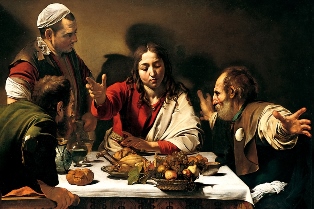
WTI Magazine #46 2014 October, 29
Author : Giuseppina Salzano e Giovanni Verde Translation by: Maria Teresa Lavota
The universal fame of Michelangelo Merisi, simply Caravaggio for everybody, is not only the result of his splendid art, his pictorial innovations and the artistic novelty of his work. His popularity is also the result of an extraordinary life, as a consequence of an extreme behavior that made Caravaggio one of the most intense Italian characters of that time, admired by some but deeply hated by others. A short life, but enough to set him among the major worldwide art myths.
Michelangelo Merisi was born in Milan on September 29, 1571. His parents, both from Caravaggio, a small town, lived in Bergamo because Michelangelo's father worked as a Duomo's worker.
Thanks to the cardinal Francesco Maria del Monte, Caravaggio succeeds in coming to the roman environments, getting important orders which allow him to acquire popularity and to soon point out his extraordinary pictorial novelties. In Rome he paints masterpieces as The Crucifixion of Saint Peter, The Conversion of Saint Matthew, Saint Paul and the Angel.
Caravaggio soon becomes a myth for his followers, who find in his works a new identity given to the subjects, an almost unthinkable usage of the light, a mingling of sacred and profane characters, an almost violent humanity. But life will bring him some events that will leave the mark. On May 28 1606 in Campo Marzio, after a brawl with his rival in love Ranuccio Tomassoni, Caravaggio hurts him and wounds him fatally. The verdict of the trial for that murder was very severe: the painter was sentenced to be beheaded, a verdict which could be executed by whoever would have recognized him in the street.
The artist is forced to escape from Rome. Followed by the fear of the judgment, Caravaggio will be obsessed by the beheading in his painting, representing several times beheads, where his macabre self-portrait replaces several times the condemned.
He goes to Naples between 1606 and 1610, where he will spend a happy and productive time. In Naples he will paint Judith beheading Holofernes, The Holy Family with Saint John the Baptist, Salome with the Head of John the Baptist, The Madonna of the Rosary.
In 1607 Caravaggio leaves for Malta, hoping to be appointed Knight and thus to receive immunity. Here, he paints the Beheading of Saint John the Baptist and he is appointed Knight, but he is also reported to the authorities - one of the many complaints filed against him during those years - because he is involved in a brawl with a Knight of an above rank.
He comes back to Naples in 1609 where he paints one of his most macabre portraits: David with the head of Goliath not only is the umpteenth reference to the nightmare of the sentence, but it also represents the most realistic representation of his features. In fact the head of Goliath is the head of the painter, lightened up by Caravaggio's light.
On July 1610 Caravaggio goes to Porto Ercole. There, he would have waited for the revocation of the banishment for his death sentence by Pope Paul V. Unfortunately the boat leaves with his luggage - vital for him, because containing the priced fixed for his definite freedom, including some paintings – but he is left behind. Caravaggio tries to reach the boat, but it has already sailed for Naples. Trying to reach the boat, already with a fever, Caravaggio dies in Porto Ercole on July 18, 1610, probably because of a serious intestinal infection.
He left us his extraordinary works, his flashes of light in the paintings, the expression of the characters, the pain, the fear of the death, the anxiety of being hunt down: together with the great pictorial novelties that let Caravaggio to forever change the history of painting.



